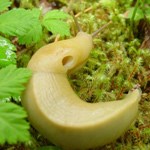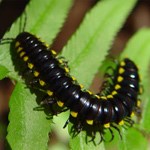|
When hiking through the redwood forest in Redwood National and State Parks one may encounter many spineless creatures, however, there are two that are highly visible and capture attention: the banana slug (Ariolimax columbianus) and yellow-spotted millipede (Harpaphe haydeniana). These two widely unrelated species (the banana slug is a mollusk and the millipede an arthropod) are often seen along trails on the forest floor (although banana slugs also may be found in low shrubs or on the boles of trees). They occur in coastal rainforests from southeast Alaska to central California. Both are detritivores, or decomposers; they consume detritus (decomposing plant and animal parts as well as feces), and are important players in nutrient cycling in the redwood forest ecosystem. 
NPS Banana Slug The banana slug is so named because it resembles- what else?- a ripe banana. It is one of the largest terrestrial mollusks, a group that also includes snails; it may grow to 7 inches (20 cm) long or greater. Some banana slugs are bright yellow like their namesake, others are greenish or brown; some have dark spots and others few or no spots. Banana slugs may be found in large concentrations, five slugs per square meter are not uncommon. Banana slugs travel on a muscular foot over a thick layer of slime. Like all other mollusks they possess an anatomical feature called a “mantle”, a muscular cavity that encloses a space containing the respiratory chamber and other organs. In banana slugs, the mantle contains a pneumostome, or breathing hole, on the right side. Banana slugs, like most other slugs, are hermaphrodites, meaning they contain both sexes within the individual, however, they rarely “self-fertilize”. Fertilized eggs are laid under logs or in leaves. In addition to its role as a detritivore, the banana slug is also a frugivore, or fruit-eater, and may play a role in seed dispersal of plants it consumes directly including raspberries and blackberries or, indirectly, through consumption of animal feces containing seeds. Raccoons, garter snakes, waterfowl, and salamanders are known to prey on banana slugs; juveniles are sometimes eaten by shrews or moles. 
Wikimedia Yellow-spotted Millipede The yellow-spotted millipede is a species of arthropod in the Myriapoda, the “many-legged ones” a group that also includes centipedes. Myriapods possess from fewer than 10 to nearly 200 pairs of appendages (“legs”). They often occur in moist climates like that of the Pacific Northwest; they may be found in damp places under stones and logs, in leaf litter, or soil. Millipedes play an important ecological role in converting forest floor litter into fertile topsoil. At certain times of the year forested trails within RNSP are literally crawling with yellow-spotted millipedes and their nymphs, which hatch small and white and take approximately two years and several molts of their exoskeleton to reach maturity.
Millipedes belong to the arthropod class Diplopoda, which means “double legs”, they have two pairs of legs per body segment. Yellow-spotted millipedes have 18-20 body segments and 31 pairs of legs (not a thousand like the name “millipede” suggests). The cylindrical body is usually black with yellow or red spots on the sides of the each segment. They move in a straight, forward motion, versus centipedes which wiggle from side to side. Unlike centipedes, but like other millipedes, yellow-spotteds do not bite. When provoked they curl up in a tight ball to protect their soft underparts. They also can release a foul-smelling toxin (hydrogen cyanide) from small pores in each leg segment. To humans the smell is pleasant and smells like almond extract, however, it is toxic to beetles and shrews in small doses.
|
Last updated: October 3, 2024
